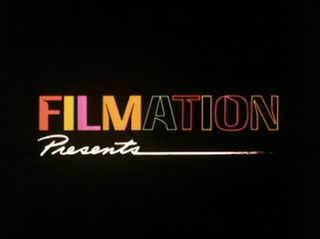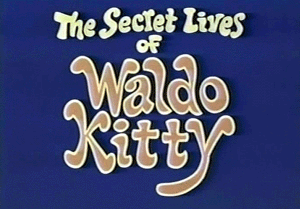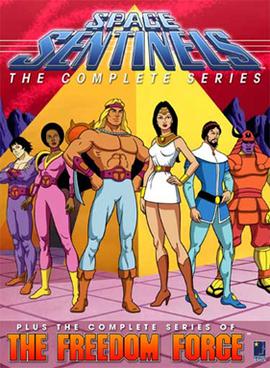
Filmation Associates was an American production company that produced animation and live-action programming for television from 1963 until 1989. Located in Reseda, California, the animation studio was founded in 1962. Filmation's founders and principal producers were Lou Scheimer, Hal Sutherland and Norm Prescott.

A gravity assist, gravity assist maneuver, swing-by, or generally a gravitational slingshot in orbital mechanics, is a type of spaceflight flyby which makes use of the relative movement and gravity of a planet or other astronomical object to alter the path and speed of a spacecraft, typically to save propellant and reduce expense.

The Mighty Hercules is an animated television series based loosely on the Greek mythology character of Heracles, under his Roman name Hercules. It debuted on television in 1963. The show ran until 1966, coinciding with the sword-and-sandal genre of films popular between 1958 and 1965. Each stand-alone episode runs 5½ minutes, and in syndication was aired either as part of a block with other cartoons, or with several episodes airing consecutively to fill 30-minute time slots.

BraveStarr is an American Space Western animated series that aired 65 episodes from September 1987 to February 1988 in syndication. The show was created a year after Mattel had released a line of action figures. BraveStarr was the last animated series produced by Filmation and Group W Productions before Filmation shut down in 1989. Reruns of the show aired on Qubo Night Owl from 2010 to 2013, and on the Retro Television Network from 2010 to 2015.

The Kid Super Power Hour with Shazam! is an NBC Saturday-morning cartoon produced by Filmation Studios in 1981. The half-hour show included two cartoon stories, with a variety of live-action wraparound segments.
Norman Zachary Prescott was co-founder and executive producer at Filmation Associates, an animation studio he created with veteran animator Lou Scheimer.

Louis Scheimer was an American producer and voice actor who was one of the original founders of Filmation. He was also credited as an executive producer of many of its cartoons.

The Tom and Jerry Comedy Show is an American animated television series produced by Filmation for MGM Television featuring the popular cartoon duo Tom and Jerry. The show first aired on September 6, 1980 on CBS and continued until December 13 the same year. Its episodes were eventually added to syndicated Tom and Jerry packages in 1983. Episodes of the show also occasionally appeared on Cartoon Network and Boomerang.
Sport Billy is an American animated television series produced by Filmation Associates, initially for broadcast in Germany. The series was a single 26 episode saga that premiered in Germany and other parts of Europe from 1980 to 1981. In 1982, Filmation carried the show over to the United States for syndication, and as a summer replacement in NBC's Saturday morning children's programming. It was the last first-run series produced by Filmation Associates to air on NBC.
Space Academy is an American science fiction television series produced by Filmation that originally aired Saturday mornings on the CBS television network, from September 10 to December 17, 1977. A total of 15 half-hour episodes were made.

The Secret Lives of Waldo Kitty is an American animated and partially live-action television series, produced by Filmation, which originally aired for one season Saturday mornings on the National Broadcasting Company (NBC) from September 6 to November 29, 1975. Howard Morris, Jane Webb, and Allan Melvin provided voices for the three main characters on the series. The show follows a cat named Waldo who daydreams of being a superhero and defeating the villainous bulldog Tyrone. It was inspired by James Thurber's 1939 short story "The Secret Life of Walter Mitty", and his widow Helen Thurber sued Filmation in 1975 for creating the series without the permission of her husband's estate. The outcome of the decision resulted in the series being retitled in future broadcasts as The New Adventures of Waldo Kitty.

Ark II is an American live-action science fiction television series, aimed at children, that aired on CBS from September 11 to December 18, 1976, as part of its weekend line-up. Only 15 half-hour episodes were produced. The program's central characters were created by Martin Roth; Ted Post helped Roth develop its core format.
The New Adventures of Mighty Mouse and Heckle & Jeckle is a 1979–1980 television series featuring newly produced Mighty Mouse and Heckle & Jeckle cartoons. The series was produced by Filmation, and aired from 1979 to 1980 on CBS with 96 episodes produced. It was the second Mighty Mouse cartoon series, following the original Mighty Mouse Playhouse from 1955 to 1967, and followed by Mighty Mouse: The New Adventures, which aired from 1987 to 1988.

Gilligan's Planet is an American Saturday morning animated series produced by Filmation and MGM/UA Television which aired during the 1982–1983 season on CBS. It was the second animated spin-off of the sitcom Gilligan's Island.
The fictional portrayal of the Solar System has often included planets, moons, and other celestial objects which do not actually exist in reality. Some of these objects were, at one time, seriously considered as hypothetical planets which were either thought to have been observed, or were hypothesized to be orbiting the Sun in order to explain certain celestial phenomena. Often such objects continued to be used in literature long after the hypotheses upon which they were based had been abandoned.

The Freedom Force is a 1978 animated television series produced by Filmation and aired on CBS as a segment of Tarzan and the Super 7. It showcased a superhero team gathered from around the world by the heroine Isis to help fight evil. While the heroine had previously appeared in the live-action television series The Secrets of Isis, actress Joanna Cameron did not reprise her role for the animated series.

The origin of Superman and his superhuman powers have been a central narrative for Superman since his inception, with the story of the destruction of his home planet, his arrival on Earth and emergence as a superhero evolving from Jerry Siegel's original story into a broad narrative architype over the course of Superman's literary history and as the character's scope continues to expand across comics, radio, television and film.
Prisoner of the Judoon is the first serial of the third series of The Sarah Jane Adventures. It was first broadcast on 15 and 16 October 2009.












